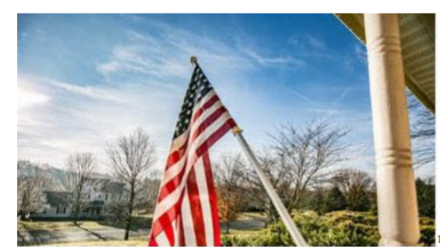Flag Day Greetings
On Flag Day during this troubled time, we send our hope that you and yours are well. We report on a precedential opinion by the Trademark Trial and Appeal Board (TTAB) upholding the refusal to register a mark because it depicted a simulation of the American flag.
 |  |
| Applicant's Mark | Comparison |
The Case
The Alabama Tourism Department (“Applicant”) filed an intent-to-use application to register the circular mark depicted above for ”advertising and marketing services, namely promoting travel and tourism related to historical information on civil rights in the United States.” The Examining Attorney refused registration on the ground that the mark included a simulation of the American flag.
On appeal, the TTAB affirmed the refusal to register this mark.
Applicable Law
The Federal Flag Code, Title 4 of the U.S. Code, sets forth various specific prohibited uses of the American flag. We previously published a Flag Day article about them.
The Trademark Act prohibits registration, on either the Principal Register or Supplemental Register, of a mark that “[c}onsists of or comprises the flag . . . of the United States . . . .” Trademark Act Section 2(b), 15 U.S.C. § 1052(b). This absolute bar reflects the view that the flag is a symbol reserved for signifying government authority.
The U.S. Patent and Trademark Office (USPTO) Trademark Manual of Examining Procedure (TMEP) § 1204.019(a)-(b) contains guidelines and examples as to when a mark with a flag design would or would not be perceived to simulate an actual American flag. It provides that such a mark should not be refused registration if:
- The flag design is used to form a letter number, or design.
- The flag is substantially obscured by words or designs.
- The design is not in a shape normally seen in flags.
- The flag design appears in a color different from that normally used in the national flag.
- A significant feature is missing or changed.
Arguments and Analysis
In this case, Applicant argued that its flag design did not simulate the entire American flag. But the TTAB pointed out that the Applicant’s original description of its mark identified the flag as the U.S. flag, and the reference in the mark to “U.S. CIVIL RIGHTS TRAIL” left no doubt that the average member of the public would perceive it to simulate an actual U.S. flag.
Applicant specifically argued that its flag design was missing or had changed features of the American Flag, namely, the overall rectangular shape; multiple missing stripes; stars (shown instead as white dots); blue rectangle (shown instead as a triangle), and that its flag design faced backward. The TTAB stated that these arguments missed the mark since the well-known features of the American flag do not disappear or change just because they may not be entirely visible the American flag is displayed on a slanted pole.
Applicant also argued that the flag element was part of a greater depiction of a civil rights movement scene. The TTAB pointed out that the flag design was not incorporated into wording or another design element, but instead was self-standing.
Next, Applicant argued that its flag design was obscured by silhouettes of the walking figures, but the TTAB concluded that the flag remained clearly visible.
Finally, Applicant argued that third party registrations of marks with flag designs showed that the USPTO had been inconsistent. The TTAB said that, while consistency is highly desirable, it must yield to proper determinations under the Trademark Act and rules.
In re Alabama Tourism Department, Application No. 87599292 (T.T.A.B. May 6, 2020).
William M. Borchard
Counsel
Email | 212.790.9290
Bill advises on domestic and international trademark matters at the highest level. His practice consists of counseling clients and handling domestic and international trademark and copyright matters including clearance, registration, proper use, licensing, contested administrative proceedings and infringement claims.
